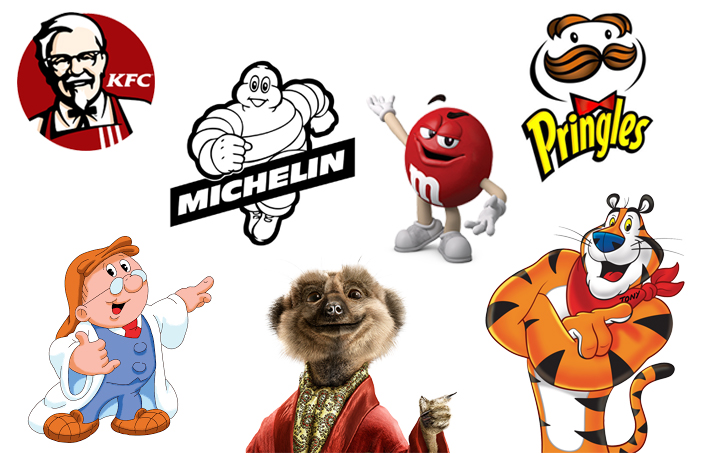In my early days in marketing, I recall the famous characters who left an indelible impression on me. These characters didn’t just represent a brand; they became a part of our lives, influencing our decisions and instilling a sense of loyalty that extended beyond the products themselves. In this article, we will look at iconic brand characters and their influence on consumer loyalty. From Tony the Tiger to the Geico Gecko, these characters have demonstrated how a well-designed mascot can be an effective tool for developing and keeping client relationships.
What is a Brand Character?
A brand character represents your company’s personality. It’s how you want people to see your company, and it should be represented in everything from your marketing materials to how you handle customer service inquiries.
Your brand identity should be consistent across all platforms and distinctive to your organization. Avoid generic characters, as they are forgettable. A dull brand persona will not help you stand out from the crowd.
Consider your brand character to be the actor representing your organization. They should be able to represent all of the values and characteristics that you want people to associate with your company.
What Makes a Brand Character Iconic?
Brand characters are the face of a company, representing its beliefs, personality, and mission. They are intended to establish an emotional connection with the viewer, making the brand more relatable and memorable. A study by Psychology Today found that individuals are more likely to recall and trust a brand with a distinctive character.
Why Do Iconic Characters Stand Out?
Iconic characters share a few common characteristics: they are memorable, relatable, and consistent. These characters frequently share stories that connect with the audience, instilling a sense of familiarity and trust. Tony the Tiger from Kellogg’s Frosted Flakes, for example, is more than simply a mascot; he represents fun and enthusiasm, encouraging both children and adults to begin their day with a cheerful attitude.
Qualities of Brand Character
When designing your brand character, there are some characteristics that they should have. These characteristics will be exclusive to your organization, but some examples include:
- Friendliness: Your brand character should be someone with whom people would like to interact. They should be personable and easy to speak with.
- Trustworthiness: People should be able to trust your brand’s character. They should believe that they can rely on them for truthful information.
- Expertise: Your brand persona should be an expert in their subject. They should be someone others can turn to for help and direction.
- Enthusiasm: Your brand character should be passionate about your products or services. They should be passionate and excited about their work, and this should be evident in their interactions with clients.
These are just a few examples of attributes your brand character could have. It is critical to select attributes that are beneficial to your business and those you want people to identify with your brand.
A Step-by-Step Guide to Developing an Iconic Brand Character
Developing an iconic brand character is a strategic process that entails understanding your brand’s personality, recognizing your target audience, and telling a captivating story. These characters are more than simply mascots; they are effective marketing tools that represent your brand’s values and connect with your target audience on a deeper level. Here’s a step-by-step method for developing a distinctive and effective brand character.
Step #1. Define your brand’s personality
Understanding your brand’s personality is the first step toward developing a persona that effectively represents your firm. Is your brand joyful and humorous, or serious and professional? This personality should be mirrored in all aspects of your character, including its appearance and voice.
Why It Matters
Your brand’s personality determines the tone of your character. It guarantees that your character connects with your target audience and complements your brand’s overall image. For example, a playful and adventurous brand like Disney would have characters that are whimsical and imaginative, whereas a professional brand like IBM would have characters that are more serious with authority.
How to Determine Your Brand’s Personality
- List Key Traits: Determine the key characteristics that distinguish your brand. These could include descriptors like inventive, dependable, entertaining, or sophisticated.
- Create a Brand Archetype: Select a brand archetype that best represents your organization, such as The Hero, The Innocent, or The Sage.
- Reflect in Character Design: Make sure your character’s appearance, speech, and conduct reflect these characteristics consistently.
Example: When developing our brand’s personality, we prioritized attributes such as innovation and sustainability. This influenced us to develop a character who was both forward-thinking and environmentally conscientious.
Step #2. Understand Your Audience.
Knowing your audience’s preferences, attitudes, and habits is essential for creating a character that connects with them. Conducting market research and developing thorough buyer personas can provide significant insights into what your target audience will find appealing and relatable.
Why It Matters
A character who connects with your target audience can foster a stronger emotional bond and improve brand loyalty. Understanding your audience allows you to tailor your persona to their tastes and preferences.
How to Understand Your Audience
- Conduct Surveys and Focus Groups: Get firsthand feedback on your target audience’s preferences and values.
- Analyze Data: Use Google Analytics and social media insights to learn about your target audience’s behavior and interests.
- Create Buyer Personas: Build thorough profiles of your ideal customers, including demographics, psychographics, and purchasing habits.
Example: For our eco-friendly brand, we conducted surveys to better understand our target audience’s environmental concerns and beliefs. This enabled us to create a figure who exemplifies these principles and appeals to our audience’s desire for sustainability.
Step #3. Create a compelling backstory.
A character with a well-crafted past might elicit a stronger emotional response from your viewers. This backstory should be consistent with your brand’s values and mission, creating a narrative that your audience can relate to and care about.
Why It Matters
A rich past gives dimension to your character, making them more sympathetic and unforgettable. It gives your audience something to relate to emotionally, increasing their commitment to your brand.
How to Create a Strong Backstory
- Align with Brand ideals: Ensure that your brand’s history reflects its mission and ideals.
- Create a Journey: Write a story about the character’s origins, hardships, and growth.
- Make it Relatable: Include elements that your audience may relate to, such as overcoming challenges or following aspirations.
Example: Our character’s backstory begins in a polluted city and ends with him becoming an advocate for clean living and sustainability. This narrative reflects our brand’s objective and appeals to our environmentally concerned clientele.
Step #4. Maintain Consistency Across Platforms
Once your character has been formed, it is critical to ensure consistency in how it is displayed across all marketing platforms. This involves ensuring that the character’s appearance, voice, and behavior remain consistent across all advertising, social media posts, and promotional materials.
Why It Matters
Consistency promotes recognition and trust. When your persona is portrayed consistently across all platforms, it strengthens your brand identity and makes them more recognizable.
How to Maintain Consistency
- Create a Style Guide: Create a detailed guide that contains visual aspects, voice, and behavior standards for your character.
- Train Your Team: Ensure that everyone involved in marketing and communications understands and adheres to the style guide.
- Monitor Implementation: Conduct regular reviews of marketing materials to maintain uniformity.
Example: We developed a comprehensive style guide for our characters, detailing everything from their color palette to their speaking patterns. This strategy guaranteed that our character was consistent across all platforms, including our website and social media networks.
Step #5. Engage With Your Audience
Finally, actively connecting with your audience through your character can assist in fostering a greater connection and loyalty. This can be accomplished through interactive social media campaigns, tailored communications, and even live events starring your brand figure.
Why It Matters
Engagement keeps your audience interested and connected in your brand. It converts passive followers into active participants, instilling a sense of community and loyalty.
How to Engage With Your Audience
- Interactive Campaigns: Run campaigns that invite audience interaction, such as contests or challenges with your character.
- Personalized Messages: Use your character to send and receive personalized messages and responses on social media.
- Live Events: Organize events where your character can connect with fans, both electronically and in person.
Example: We announced a social media contest in which followers may contribute their environmentally friendly activities for a chance to be featured by our character. This not only increased participation but also enhanced our community of environmentally concerned consumers.
By following these steps, you can create an iconic brand character that connects with your target audience, strengthens your brand’s identity, and fosters long-term consumer loyalty.
Examples Of Iconic Brand Characters
#1. Tony the Tiger (Kellogg’s Frosted Flakes)
Tony the Tiger has been the symbol of Kellogg’s Frosted Flakes since 1952. His upbeat and optimistic nature has made him a cherished character for years. Tony’s tagline, “They’re grrreat!” is instantly memorable and has helped the brand’s long-lasting appeal. A study conducted by Statista discovered that firms with mascots have a 37% greater interaction rate on social media, illustrating the impact of characters like Tony.
#2. The Geico Gecko
The Geico Gecko, introduced in 1999, rapidly became a fan favorite due to its hilarious and sympathetic demeanor. The character’s British accent and funny remarks helped Geico stand out in the highly competitive insurance market.
According to Geico, their mascot has helped boost brand recognition and consumer loyalty.
#3. Ronald McDonald
Ronald McDonald has represented McDonald’s since the 1960s. He is a cheerful and approachable clown, and represents fun and family-friendly dining experiences. McDonald’s has used Ronald in a variety of community and charitable events, thereby amplifying the character’s beneficial impact. According to McDonald’s, Ronald McDonald House Charities have considerably improved the brand’s reputation and loyalty.
#4. M&M Characters
M&M’s characters, each with their own personality, have increased the brand’s appeal and relatability. From the confident Red to the nervous Yellow, these characters inject fun and personality into the brand. According to Candy Industry, M&M’s characteristics have contributed to the brand’s excellent market position and consumer devotion.
#5. Aflac duck
The Aflac Duck, which debuted in 1999, helped Aflac gain tremendous brand recognition in the insurance sector. The duck’s amusing and persistent attitude has made it distinctive and successful at expressing the brand’s message. According to Aflac, their mascot has considerably helped to raise brand awareness and consumer engagement.
#6. Twitter’s Larry Bird
It seems logical that a website called Twitter would choose a bird as its brand character. Larry the Bird is named after basketball legend Larry Bird, as co-founder Biz Stone is a Celtics devotee. Despite its diminutive size, this little blue bird is synonymous with Twitter even when the brand name is not explicitly stated.
The bird logo is adaptable. It’s utilized not only for website branding but also in the corner of each individual’s tweet. It is widespread yet not intrusive.
The Impact of Brand Characters on Consumer Loyalty.
#1. Creating Emotional Connections
Brand characters foster emotional connections with customers by expressing the brand’s values and personality. Customers feel more familiar and trusting of the character as a result of these ties.
#2. Increasing Brand Recall
Characters make brands more memorable, resulting in increased brand recall. According to a study conducted by Nielsen, advertising containing mascots is 30% more likely to improve brand remember than those without.
#3. Improving Customer Engagement
Interactive campaigns with brand characters can greatly increase client engagement. Social media challenges, personalized messaging, and events featuring brand mascots all provide opportunities for meaningful interactions with customers.
Brand Character vs. Brand Personality
It’s critical to recognize the distinction between a brand character and a brand personality. A brand character is a person who you develop to represent your brand. A brand personality, on the other hand, represents your company’s entire tone and feel.
Your brand character should reflect your brand’s personality in its own distinctive way. They should share your brand’s values and attributes while still having their own unique personality.
Are you ready to build your own iconic brand character? Download our Brand Character Development Template to get started creating a distinctive and effective mascot for your brand.
Brand Character Development Template
Takeaways
- Brand characters establish deep emotional connections, which drive customer loyalty.
- Characters improve brand remember and make your brand more memorable.
- Interactive campaigns that use brand characters increase customer engagement.
- Consistent character portrayal across all platforms enhances brand identity.
- Understanding your target audience is essential for developing a relatable and effective brand identity.
Conclusion
Brand characters are more than simply mascots; they are effective instruments for increasing consumer loyalty and brand success. You may develop long-term emotional ties with your audience and increase customer engagement by building characters who exemplify your brand’s ideals. What persona will you design to reflect your brand and engage your audience?
Related Articles
- 7 Simple Practical Steps to Build Brand Loyalty
- What is Brand Advertising? How To Build Brand Awareness
- Strategies for Building an Internal Brand at Your Company: 11 Ultimate Tips
- 10 Essential Strategies For Effective International Brand Management
- Brand Marketing vs. Content Marketing: How They Differ and Work Together





